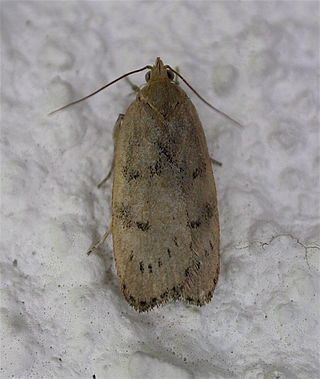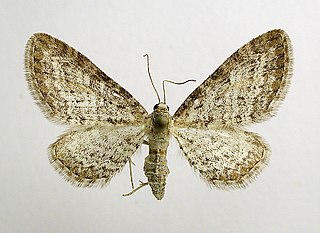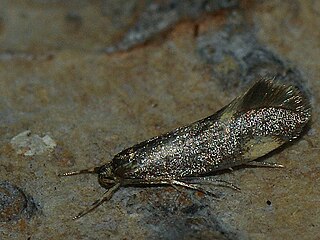
The slender pug is a moth of the family Geometridae. It was first described by Jacob Hübner in 1813 and is found throughout Europe and western parts of the Palearctic. The larva feeds on the catkins of willow.

The black arches or nun moth is a small Palaearctic moth. It is considered a forest pest.

Agrochola lychnidis, the beaded chestnut, is a moth of the family Noctuidae. The species was first described by Michael Denis and Ignaz Schiffermüller in 1775. It is distributed throughout the whole of Europe from Ireland to the Urals. It also occurs in western North Africa and Asia Minor.

Idaea fuscovenosa, the dwarf cream wave, is a moth of the family Geometridae. It is found in the Palearctic,

Pandemis cerasana, the barred fruit-tree tortrix, is a moth of the family Tortricidae.

Argyresthia curvella is a species of ermine moth. It belongs to subfamily Argyresthiinae, which is sometimes elevated to full family rank in the superfamily Yponomeutoidea. It is commonly called apple blossom tineid, reflecting the fact that it was originally believed to be a tineid moth.

Heliothis peltigera, also known as the bordered straw, is a species of moth of the family Noctuidae.

Utetheisa pulchella, the crimson-speckled flunkey, crimson-speckled footman, or crimson-speckled moth, is a moth of the family Erebidae. The species was first described by Carl Linnaeus in his 1758 10th edition of Systema Naturae.

Diacrisia sannio, the clouded buff, is a moth of the family Erebidae. The species was first described by Carl Linnaeus in his 1758 10th edition of Systema Naturae.

Eriocrania chrysolepidella is a moth of the family Eriocraniidae found in Europe. It was first described by the German entomologist, Philipp Christoph Zeller in 1851. The larvae mine the leaves of hazel and hornbeam.
Metalampra is a genus of the concealer moth family (Oecophoridae). Among these, it belongs to subfamily Oecophorinae. It was originally established as a subgenus of Borkhausenia.

Phaeosaces coarctatella is a species of moth in the family Oecophoridae. It is endemic to New Zealand and can be found throughout the country. The preferred habitat of this species is native forest however they can also be found in domestic gardens. Larvae shelter in hollow twigs or under bark and emerge at night to browse on lichens. They pupate within their shelter. Adults are on the wing from September to January and are variable in their appearance. They vary both in colour, from reddish brown to a greenish yellow shade, and also in the extent of the black marking on their forewings. They are nocturnal and are attracted to light.

Eupithecia subumbrata, the shaded pug, is a moth of the family Geometridae. The species was first described by Michael Denis and Ignaz Schiffermüller in 1775. It is found from Mongolia and the Altai Mountains through Siberia, central Asia, Asia Minor and Russia to western Europe and from central Scandinavia to the Mediterranean region.

Izatha attactella is a moth of the family Oecophoridae. This species is endemic to New Zealand, where it is known from both the North and South Islands as far south as mid-Canterbury. Larvae of this species feed on the soft inner surface of the bark of dead trees and shrubs. Adults have been recorded from September to December.

Izatha austera is a species of moth in the family Oecophoridae. It is endemic to New Zealand. The larvae of this species feed on dead wood by tunnelling into branches of its host species. The larvae matures from September and is on the wing in the months of December to January. The adult moth is variable in colouration but is seldom observed.

Izatha huttonii is a moth of the family Oecophoridae. It is endemic to New Zealand, where it is known from the Wellington district of the North Island, the South Island, and Stewart Island. Although similar in appearance to related species I. huttonii can be distinguished as it has a distinctive M-shaped mark on its forewings. The larvae feed on the dead wood of makomako and karamu. Adult moths have been collected from October to March.

Metalampra cinnamomea is a moth of the family Oecophoridae. It was described by Philipp Christoph Zeller in 1839. It is found in most of Europe, except the Iberian Peninsula, most of the Balkan Peninsula, Ireland and Great Britain.

Bactra bactrana is a species of moth of the family Tortricidae. It is found on the Canary Islands, Sicily and Malta and in southern Spain, Portugal, southern Italy, France, Greece, Morocco, Algeria, Egypt, Asia Minor, Arabia, Iraq, Iran, the Caucasus, Afghanistan, the Caspian area, Tajikistan, Kyrgyzstan, Uzbekistan, Pakistan, India, the Republic of Congo, Madagascar, Sudan and Gambia.

Eucosma cana, the hoary bell, is a species of moth of the family Tortricidae.

Hierodoris bilineata is a species of moth in the family Oecophoridae. It is endemic to New Zealand. This species is classified as "At Risk, Naturally Uncommon" by the Department of Conservation. It is possible that this species gives birth to live young rather than lay eggs as is the norm.




















